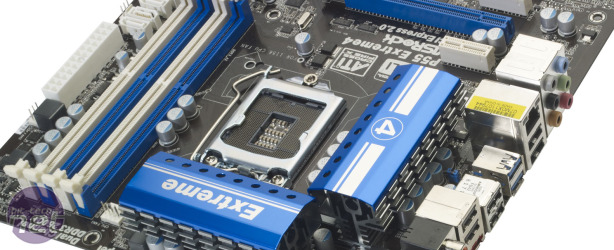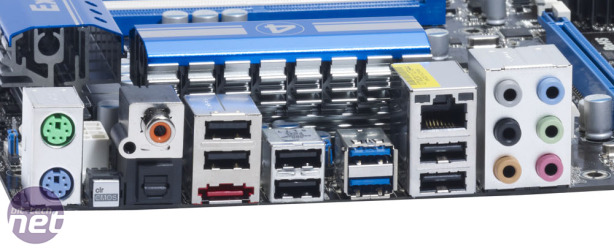Performance Analysis
The ASRock P55 Extreme4 didn’t prove extremely fast in our testing, nor extremely slow. In fact, when it came to performance, the Extreme4 wasn’t extreme in any way. Throughout our Media Benchmark testing, the Extreme4 performed reasonably well, except in the multi-tasking test where the board was a bit slow. A score of 1,161 is roughly 40 points slower than the next fastest motherboard, and over 100 points slower than fastest LGA1156 board we’ve seen so far.With our new SATA tests and Crucial C300 SATA 6Gbps SSD, the Extreme4's native SATA 3Gbps ports performed fairly well. However, the two Marvell SATA 6Gbpa ports were extremely slow in comparison to other motherboards, with read speeds of around 123MB/sec and write speeds of around 205MB/sec. We’d have hoped for read speeds of around 210MB/sec and write speeds of over 300MB/sec.
Gaming performance was similarly disappointing, with a minimum of 24fps at stock speeds and of 26fps when overclocked. Every other board we've tested was faster, if only by a few fps.
Overclocking
The BIOS of the Extreme4 is packed with options and unique ASRock extras, such as the Good Night LED option which switches off keyboard and on-board lights when the PC is turned off – handy if you have it in your bedroom. The BIOS also has two methods of automatic overclocking: Turbo 50 is the most confusing, as it offers to overclock the system by 40 or 50 per cent. Both overclocks apply sensible settings for most components, with the 40 per cent option applying a Base Clock of 190MHz, a vcore of 1.35V and a raising the VTT to 1.265V. However, the auto-overclock mystifyingly set our 1,600MHz memory at 1,140MHz when it could have opted for 1,520MHz via an 8x memory strap.The results of this overclock were terrible too – the image editing score dropped from 1,196 to 757 points while the video encoding test ran only 9 per cent faster despite the 42 per cent rise in CPU frequency. The 50 per cent option overclocked our memory to 2,000MHz and as a result the system wouldn’t POST. Annoyingly, the Extreme4 is terrible at recovering from a failed overclock, and we had to power it down and clear the CMOS after this silly auto-overclock.
We therefore applied our overclock manually. First off we wanted to establish the maximum stable Base Clock that the board was capable of and were impressed that we could squeeze 220MHz from it. This is as fast as any P55 board we’ve looked at, and a firm indication that the Extreme4 is made from high-quality components. We therefore applied the maximum air-cooled overclock that our CPU can manage with some confidence.
We used a Base Clock of 200MHz and the default CPU multiplier of 20x to overclock the CPU from 2.66GHz to 4GHz. We avoided using the 21x multiplier offered via the Turbo option as this can cause issues (the overclock would be governed by the laws of Turbo Boost, and so might step down if the CPU drew too much power for this feature’s liking), and wanted to use a 200MHz Base Clock to allow our memory to run at 1,600MHz. We used a vcore of 1.5V, a VTT of 1.31V, a PCH of 1.3V and a CPU PLL of 1.9V.
The BIOS is friendly to use, with logically collated and organised menus, and while you can’t type in voltages as with some other motherboards, the lists weren’t extraneously long and unwieldy either. There are three save slots for BIOS profiles, all of which can be given custom names, and there’s an integrated BIOS flashing tool too.
The overclock saw the kind of performance improvements we’d expected from the Turbo 50 option, with the overall score rising from 1,421 to 1,965 points (a 38 per cent speed increase). Crysis ran 3-8fps faster too.
Conclusion
ASRock‘s P55 Extreme4 might look like a brilliant motherboard with plenty of useful features, but it performed below average in many of our tests, which is a disappointment for a P55 board costing around £120. While its auto-overclocking tools failed to work, manually overclocking the board was easy and straitforward, at least until we tried to push it too far and the board failed to recover without us clearing the CMOS. We had thought the days of clearing the CMOS after failed overclocks were behind us.The slow SATA 6Gbps ports are also irritating, as other boards using the same Marvell controllers are so much faster. This means the £80 Gigabyte GA-P55M-UD2 is still our favourite P55 motherboard.
Note: since posting this review, the issue with the board not waking up has been resolved.
This board is now on sale for £111.12 (inc VAT), and given the price we have adjusted the scores accordingly.
- Performance
- x
- x
- x
- x
- x
- x
- x
- -
- -
- -
- 7/10
- Features
- x
- x
- x
- x
- x
- x
- x
- x
- -
- -
- 8/10
- Value
- x
- x
- x
- x
- x
- x
- -
- -
- -
- -
- 6/10
- Overall
- x
- x
- x
- x
- x
- x
- -
- -
- -
- -
- 6/10

MSI MPG Velox 100R Chassis Review
October 14 2021 | 15:04












Want to comment? Please log in.